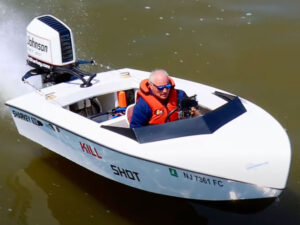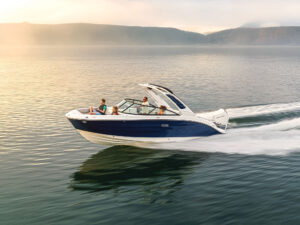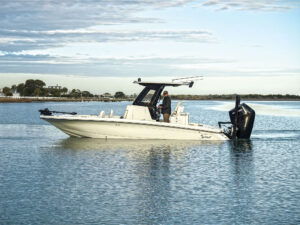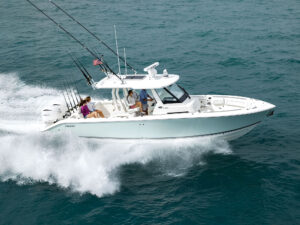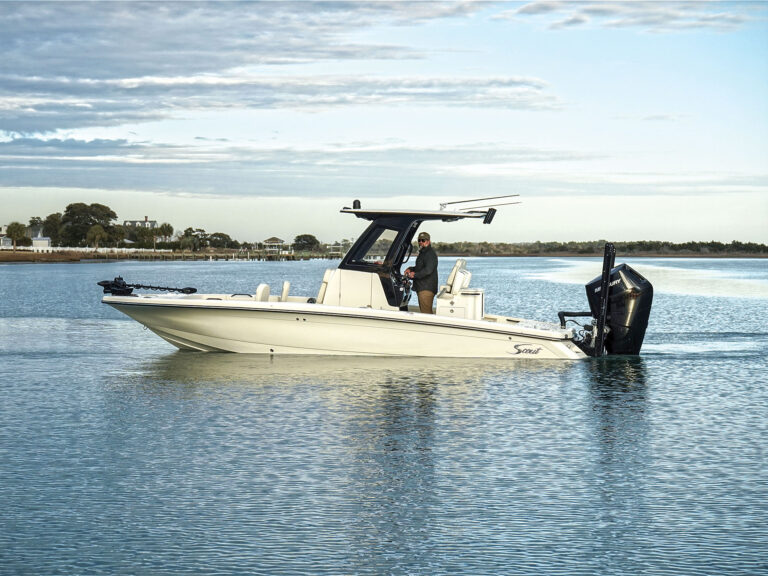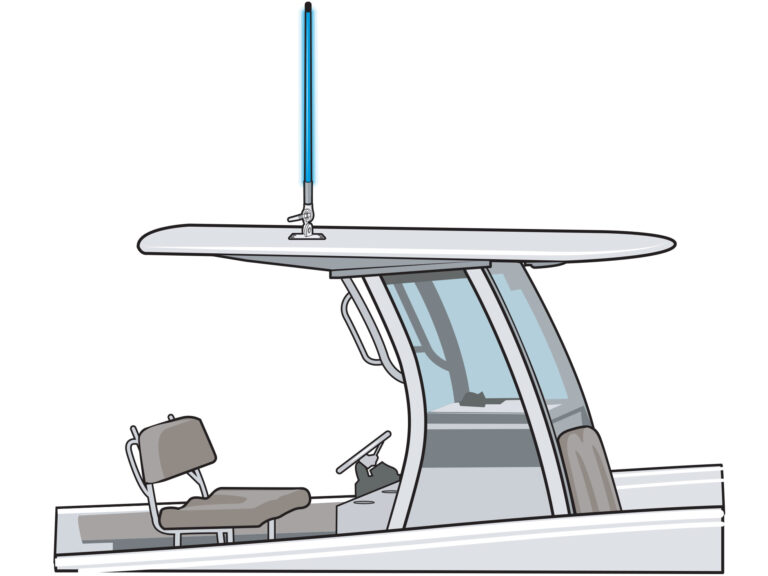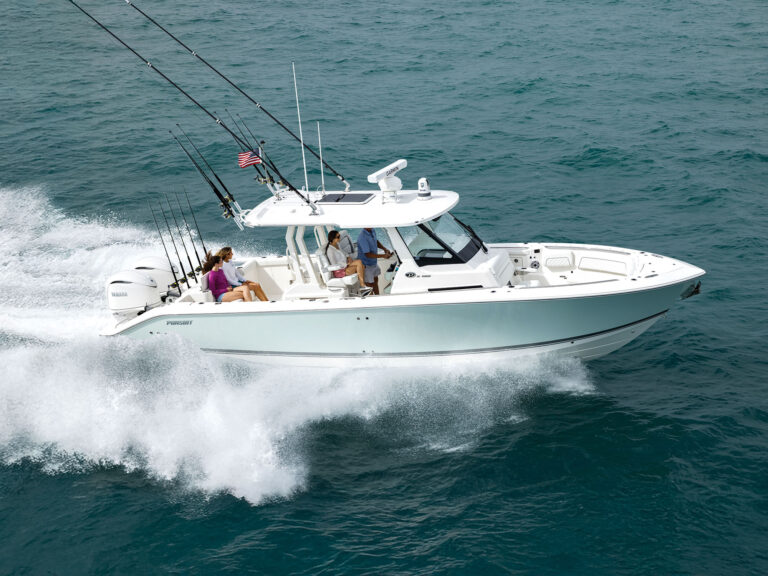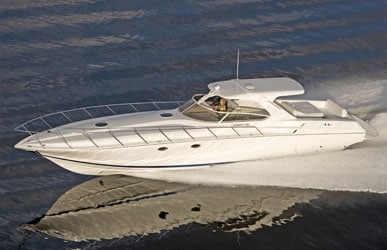
Fountain 48 Express Cruiser
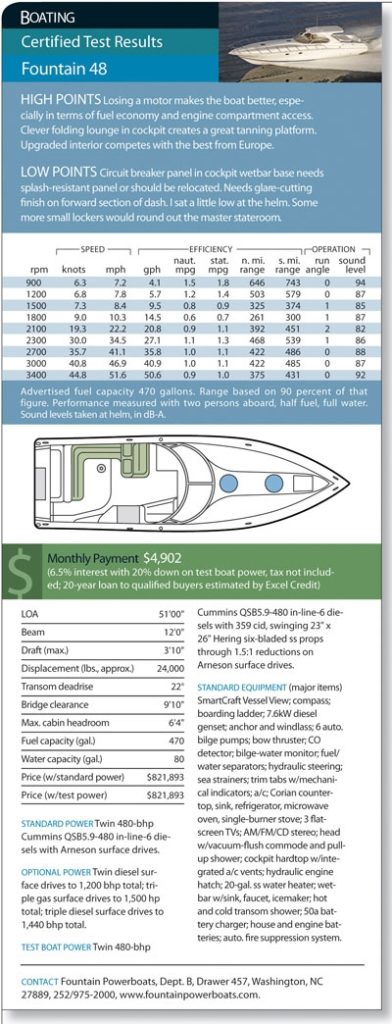
Fountain 48 Express Cruiser
You’d be right to look at Fountain Powerboats CEO Reggie Fountain and conclude that he’s obsessed. You’d be wrong if you thought that his sole obsession is speed. In test after test of his boats, Fountain touts their efficiency, and his 48 Express Cruiser is no exception. The boat planes in 4.9 seconds at only 16 mph and 2000 rpm and gets better than 1 mpg through the top speed of 51.6 mph and 3400 rpm. Now that’s amazingly efficient.
You won’t find another boat in this size range that runs these speeds and burns so little fuel. The closest is the outboard-powered Intrepid 475 Sport Yacht. With four Mercury 300 XS outboards, it runs 52 mph and nets 0.8 mpg. It retails for $700,770 with the quartet of motors.
When Fountain and I were part of a foursome that set an endurance record from Key West, Florida, to Cancun, Mexico, we used a 48 Express Cruiser powered by triple Yanmar diesels with Arneson surface drives. It ran 65 mph, but the company found that few customers wanted or needed to go that fast. Plus, at that speed, the belowdecks components took a beating. So Fountain scaled back to twin 480-bhp Cummins QSB5.9 diesels. With Arneson ASD-8 surface drives, the boat hits a respectable 51.6 mph. The twin-stepped bottom design hasn’t changed and the handling hasn’t suffered. I turned the boat at wide open and it carved effortlessly. Plus, a driver’s ability to trim the Arnesons makes the 48 Express Cruiser more versatile. In rough water trim down the drives and the tabs, and you’re on plane and making headway at only 18 mph. A conventional straight-shaft inboard would be wallowing in the waves. And when the waves lay down, you can lean on the throttles and trim up the drives to top 50 mph or cruise smoothly at 41 mph at 2700 rpm or 34.5 at 2400.
Downsizing
The motors are installed side-by-side in a straightforward layout with all the trim pumps, fuel/water separators, and tank-switching valves on a powder-coated aluminum panel on the starboard side of the compartment. The sea strainers are forward. On our test boat, the generator was centrally located forward of the motors with the batteries to port in plastic boxes. This made it a little tough to remove a battery. On future models, Fountain says it will put the generator on the port side with the batteries in the middle, a more serviceable location.
While in the engine compartment, I noted the extra-thick stringers, which consist of multiple Coosa composite panels encapsulated in fiberglass. The balance of the 48 Express Cruiser’s laminate includes foam coring and bi- and quad-directionally woven fiberglass with vinylester resin. The hull-to-deck joint is sealed with Plexus adhesive and finished with fiberglass tabbing.
Euro Chic
In addition to the new standard hardtop, the 48 Express Cruiser’s interior has been upgraded and it now rivals anything you’d see from Pershing, Fairline, or Sunseeker. Starting at the transom, there’s a large trunk locker that opens on twin stainless-steel gas struts. It houses all the boat’s utility hookups and accompanying circuit breakers, which are behind a splash-proof acrylic panel.
A full gate closes off the portside passage that leads from the stern to the cabin entry. Across the stern is a two- to three-person bench that, with the push of a switch, lifts up on a hydraulic assembly to extend the sunlounge over the engine compartment. The main part of the flat sunlounge raises on twin large pneumatic struts to reveal a locker that can stow the cockpit table.
To port the wetbar includes a sink and a refrigerator. Fountain put the circuit breakers in the base of the sink cabinet, which gives me pause. At the least, these should be protected by a splash-proof panel.
There are two individual bolsters at the helm with hydraulically controlled bottom cushions. I felt a little low even with the seat all the way up. My optimum position was to angle the bottom cushion and lean back against it.
Aside from the gleaming white dash, I was impressed with the 48 Express Cruiser’s helm. You won’t find another 48′ cruiser with mechanical trim indicators cut into the dash for the drives and tabs. A SmartCraft Vessel View screen kept me apprised of the engine functions, and I maintained speed with Glendinning controls. The boat is well equipped. Also, I want to point out the small two-shelf locker adjacent to the driver’s feet. Kudos to Fountain for providing convenient small-item stowage.
The final change was to eliminate the second head belowdecks. The Intrepid is also a single-head boat. If you’re interested in twin heads and a more traditional style, check out the Sea Ray 48 Sundancer ($932,538 with twin 517-bhp Cummins QSC8.3-540 inboards).
Belowdecks, there’s a midcabin with an athwartship-facing two-person lounge. At the foot of the berth is a locker with surprising capacity.
Forward to port is a large lounge with seating for at least six. Across to starboard, the galley includes a single-burner stove, plus a refrigerator and plenty of stowage. There’s also a microwave, but again I ask, why don’t boatbuilders put fiddles on their countertops?
In the bow, the master stateroom has a large double berth with a deck hatch overhead. There’s a flat-screen TV and a Denon stereo. There’s a hanging closet to starboard, but I’d have preferred more small lockers.
From the master quarters you enter the only head, which includes a vacuum-flush toilet, stainless-steel sink, and pull-up shower. What did you expect? Just because Fountain got rid of one engine doesn’t mean it did away with all the amenities.
Extra Point: Want to know how smoothly the boat rides? A roll of duct tape that was accidentally left in the engine compartment was still in the same spot after we concluded the sea trial.

